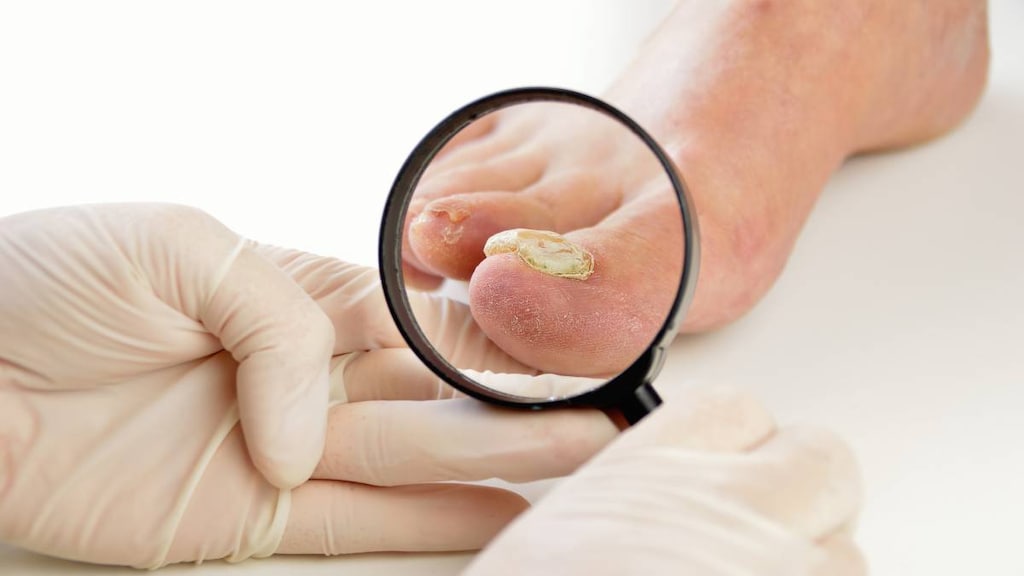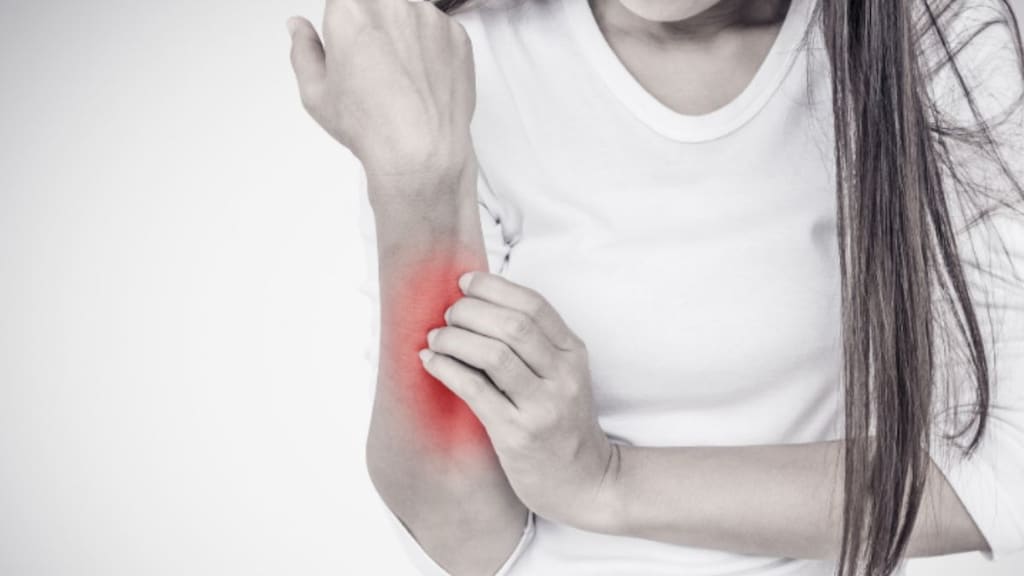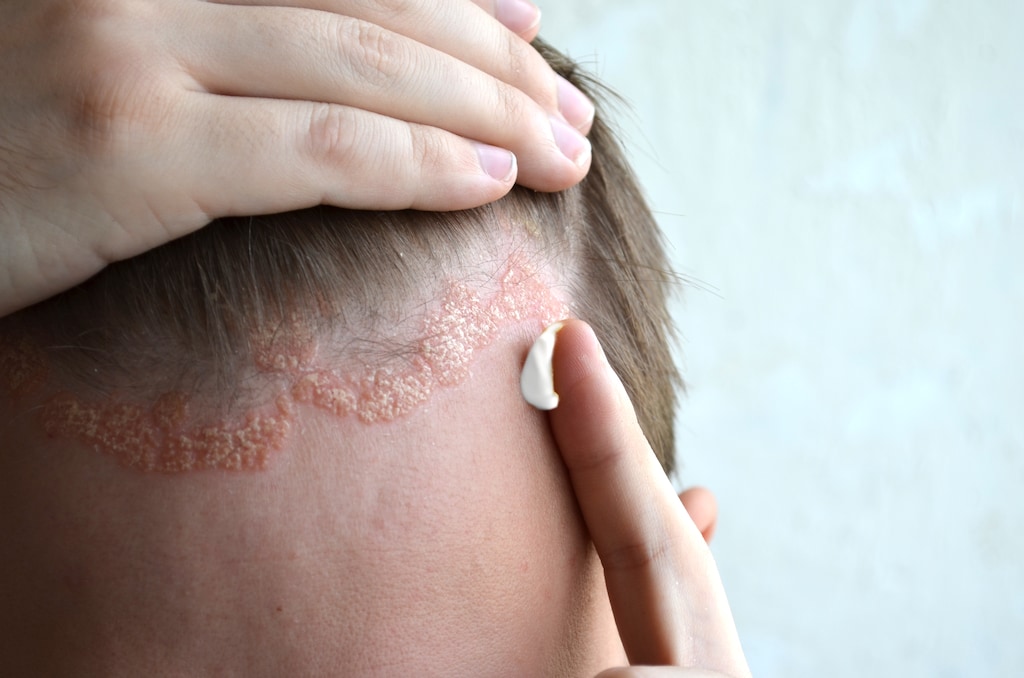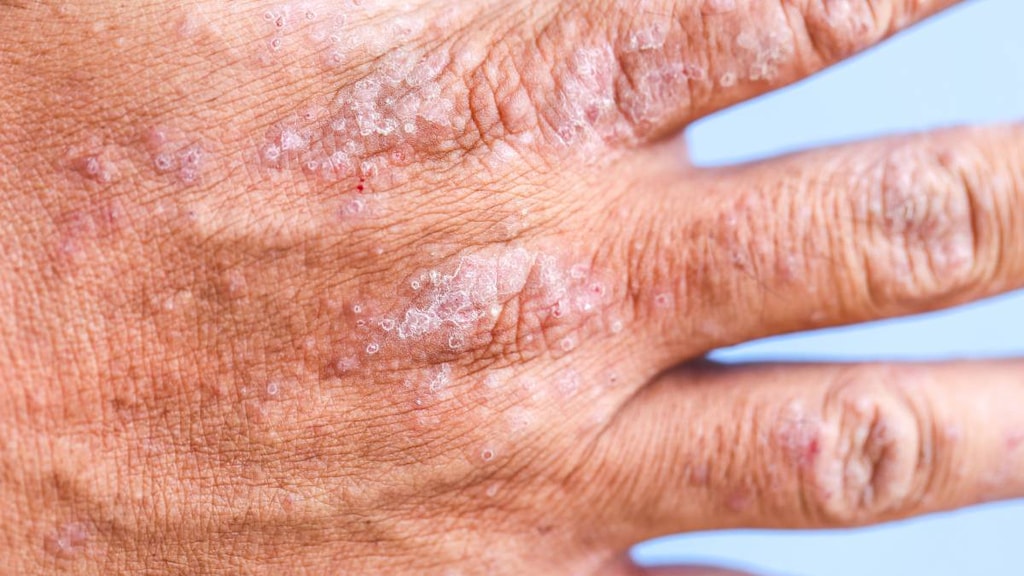Dosage Forms
Excipient information presented when available (limited, particularly for generics); consult specific product labeling. [DSC] = Discontinued product
Cream, External, as propionate:
Clobetasol Propionate E: 0.05% (15 g, 30 g, 60 g) [contains cetostearyl alcohol, propylene glycol]
Clobetasol Propionate E: 0.05% (15 g, 30 g, 60 g) [contains propylene glycol]
Impoyz: 0.025% (60 g [DSC], 100 g) [contains cetostearyl alcohol, methylparaben, propylparaben]
Temovate: 0.05% (30 g, 60 g) [contains cetostearyl alcohol, chlorocresol (chloro-m-cresol), propylene glycol]
Temovate E: 0.05% (60 g [DSC])
Generic: 0.05% (15 g, 30 g, 45 g, 60 g)
Foam, External, as propionate:
Olux: 0.05% (50 g [DSC], 100 g [DSC]) [contains cetyl alcohol, propylene glycol]
Olux: 0.05% (50 g, 100 g) [cfc free; contains alcohol, usp, cetyl alcohol, propylene glycol]
Olux-E: 0.05% (50 g [DSC], 100 g [DSC]) [contains cetyl alcohol, propylene glycol]
Olux-E: 0.05% (50 g, 100 g) [cfc free; contains cetyl alcohol, propylene glycol]
Tovet: 0.05% (100 g) [contains cetyl alcohol, propylene glycol]
Generic: 0.05% (50 g, 100 g)
Gel, External, as propionate:
Temovate: 0.05% (60 g [DSC]) [contains propylene glycol]
Generic: 0.05% (15 g, 30 g, 60 g)
Kit, External, as propionate:
Clodan: 0.05% [contains alcohol, usp, cetyl alcohol, edetate disodium, propylene glycol]
Tovet: 0.05% [contains cetyl alcohol, edetate disodium, methylparaben, propylene glycol, trolamine (triethanolamine)]
Liquid, External, as propionate:
Clobex Spray: 0.05% (59 mL, 125 mL) [contains alcohol, usp]
Generic: 0.05% (59 mL, 125 mL)
Lotion, External, as propionate:
Clobex: 0.05% (59 mL, 118 mL)
Generic: 0.05% (59 mL, 118 mL)
Ointment, External, as propionate:
Temovate: 0.05% (15 g, 30 g) [contains propylene glycol]
Generic: 0.05% (15 g, 30 g, 45 g, 60 g)
Shampoo, External, as propionate:
Clobex: 0.05% (118 mL) [contains alcohol, usp]
Clodan: 0.05% (118 mL) [contains alcohol, usp]
Generic: 0.05% (118 mL)
Solution, External, as propionate:
Cormax Scalp Application: 0.05% (50 mL [DSC]) [contains isopropyl alcohol]
Temovate: 0.05% (50 mL [DSC])
Generic: 0.05% (25 mL, 50 mL)
Pharmacology
Mechanism of Action
Topical corticosteroids have anti-inflammatory, antipruritic, and vasoconstrictive properties. May depress the formation, release, and activity of endogenous chemical mediators of inflammation (kinins, histamine, liposomal enzymes, prostaglandins) through the induction of phospholipase A2 inhibitory proteins (lipocortins) and sequential inhibition of the release of arachidonic acid. Clobetasol has very high range potency.
Pharmacokinetics/Pharmacodynamics
Absorption
Percutaneous absorption is variable and dependent upon many factors including vehicle used, integrity of epidermis, dose, and use of occlusive dressings (not recommended); absorption is increased by occlusive dressings or with decreased integrity of skin (eg, inflammation or skin disease); gel has greater absorption than cream
Metabolism
Hepatic
Excretion
Urine and feces
Use: Labeled Indications
Steroid-responsive dermatoses: Short-term relief of inflammation and pruritic manifestations of moderate to severe corticosteroid-responsive dermatoses
Contraindications
Hypersensitivity to clobetasol, other corticosteroids, or any component of the formulation; primary infections of the scalp (scalp solution only)
Canadian labeling: Additional contraindications (not in US labeling): Treatment of rosacea, acne vulgaris, perioral dermatitis, or perianal and genital pruritus; viral (eg, herpes or varicella) lesions of the skin, bacterial or fungal skin infections, parasitic infections, skin manifestations relating to tuberculosis or syphilis, eruptions following vaccinations; ulcerous wounds; application to eyes or eyelids; children <2 years of age (shampoo); children <1 year of age (cream, ointment, scalp application). Note: Product labels may vary (refer also to product labels).
Dosage and Administration
Dosing: Adult
Note: Discontinue when control achieved; if improvement not seen within 2 weeks, reassessment of diagnosis may be necessary.
Mild to moderate plaque-type psoriasis of nonscalp areas: Topical: Foam: Apply twice daily for up to 2 weeks (maximum dose: 50 g/week).
Moderate to severe plaque-type psoriasis: Topical:
Cream (0.025%), emollient cream, lotion: Apply twice daily for up to 2 weeks (cream) or up to 4 weeks if needed (emollient cream, lotion) when application is <10% of body surface area (maximum dose: 50 g/week or 50 mL/week). Treatment with lotion beyond 2 weeks should be limited to localized lesions (<10% body surface area) that have not improved sufficiently.
Spray: Apply by spraying directly onto affected area twice daily and gently rub into skin. Limit treatment to 4 consecutive weeks; treatment beyond 2 weeks should be limited to localized lesions that have not improved sufficiently. Maximum total dose: 50 g/week or 59 mL/week. Do not use more than 26 sprays per application or 52 sprays per day.
Oral mucosal inflammation (off-label use): Topical: Cream: Apply twice daily for up to 2 weeks (maximum dose: 50 g/week); discontinue application when control is achieved; if no improvement is seen, reassessment of diagnosis may be necessary.
Scalp psoriasis, moderate to severe: Topical:
Foam: Apply twice daily for up to 2 weeks (maximum dose: 50 g/week).
Shampoo: Apply thin film to dry scalp once daily (maximum dose: 50 g/week or 50 mL/week); leave in place for 15 minutes, then add water, lather, and rinse thoroughly. Limit treatment to 4 consecutive weeks.
Steroid-responsive dermatoses: Topical: Cream (0.05%), emollient cream, emollient foam, foam, gel, lotion, ointment, solution: Apply twice daily for up to 2 weeks (maximum dose: 50 g/week or 50 mL/week).
Dosing: Geriatric
Refer to adult dosing.
Dosing: Pediatric
Note: Dosage should be based on severity of disease and patient response; use the smallest amount for the shortest period of time to avoid HPA suppression; discontinue therapy when control is achieved; reassess diagnosis if no improvement is seen within 2 weeks. Due to the high incidence of adrenal suppression noted in clinical studies, clobetasol lotion, shampoo, and spray are not recommended for use in patients <18 years of age.
Dermatoses (steroid-responsive): Children ≥12 years and Adolescents: Topical:
Cream, emollient cream, gel, ointment: Apply sparingly twice daily for up to 2 weeks; maximum weekly dose: 50 g/week
Solution: Apply sparingly to affected area of scalp twice daily for up to 2 weeks; maximum weekly dose: 50 mL/week
Plaque-type psoriasis of nonscalp areas; mild to moderate: Children ≥12 years and Adolescents: Topical: Foam: Apply sparingly to affected area twice daily for up to 2 weeks; maximum weekly dose: 50 g/week or 21 capfuls/week
Plaque-type psoriasis; moderate to severe:
Emollient cream: Adolescents ≥16 years: Topical: Apply sparingly twice daily for up to 2 weeks; if response is not adequate, may be used for up to 2 more weeks if application is <10% of body surface area; use with caution; maximum weekly dose: 50 g/week
Lotion: Adolescents ≥18 years: Topical: Apply twice daily for up to 2 weeks; maximum weekly dose: 50 g/week or 50 mL/week)
Spray: Adolescents ≥18 years: Apply by spraying directly onto affected area twice daily and gently rub into skin. Limit treatment to 4 consecutive weeks; treatment beyond 2 weeks should be limited to localized lesions which have not improved sufficiently. Maximum weekly dose: 50 g/week or 59 mL/week. Do not use more than 26 sprays per application or 52 sprays per day.
Scalp psoriasis, moderate to severe:
Foam: Children ≥12 years and Adolescents: Topical: Apply twice daily for up to 2 weeks; maximum weekly dose: 50 g/week or 21 capfuls/week)
Shampoo: Adolescents ≥18 years: Topical: Apply thin film to dry scalp once daily; leave in place for 15 minutes, then add water, lather, and rinse thoroughly; maximum weekly dose: 50 g/week or 50 mL/week. Limit treatment to 4 consecutive weeks.
Administration
Apply the smallest amount that will cover affected area. For topical use only; avoid contact with eyes and mucous membranes. Do not apply to face, scalp, axilla, groin, or intertriginous areas. Do not use if there is atrophy at the treatment site. Do not cover, bandage, or wrap the treated area unless instructed. Minimize contact to nonaffected areas of the body. Wash hands after use.
Cream, emollient cream, gel, lotion, ointment, solution: Maximum dose: 50 g/week or 50 mL/week.
Emollient foam: Shake can before use. Turn can upside down and spray a small amount (approximately a capful) of foam into the cap. Massage foam into affected area until foam absorbed. Maximum dose: 50 g/week or 21 capfuls/week.
Foam: Turn can upside down and spray a small amount (golf-ball size) of foam into the cap or another cool surface. If the can is warm or foam is runny, place can under cold, running water. If fingers are warm, rinse with cool water and dry prior to handling (foam will melt on contact with warm skin). Massage foam into affected area. Maximum dose: 50 g/week or 21 capfuls/week.
Shampoo: Limit treatment to 4 consecutive weeks. Maximum dose: 50 g/week or 50 mL/week. Use on dry hair; do not wet hair prior to use. Do not use a shower cap or bathing cap while shampoo is on the scalp. Leave in place for 15 minutes, then wet hair, lather and rinse hair and scalp completely. Although no additional shampoo is necessary to cleanse the hair, a nonmedicated shampoo may be used after application if desired.
Spray: Spray directly onto affected area of skin. Gently and completely rub into skin after spraying. Maximum total dose: 50 g/week or 59 mL/week. Do not use more than 26 sprays per application or 52 sprays per day.
Storage
Cream, emollient cream, lotion, ointment: Store between 15°C to 30°C (59°F to 86°F); do not refrigerate or freeze.
Emollient foam, foam: Store between 20ºC and 25ºC (68ºF and 77ºF); do not expose to temperatures >49°C (120°F). Avoid fire, flame, or smoking during and immediately following application.
Gel: Store between 2°C and 30°C (36°F and 86°F).
Shampoo: Store between 20°C and 25°C (68°F and 77°F); excursions permitted between 15°C and 30°C (59°F and 86°F)
Solution: Do not use near an open flame.
Cormax: Store between 15°C to 30°C (59°F to 86°F).
Temovate: Store between 4°C to 25°C (39°F to 77°F).
Spray: Store at room temperature; do not expose to temperatures >30°C (86°F). Do not freeze or refrigerate. Spray is flammable; do not use near open flame.
Drug Interactions
Aldesleukin: Corticosteroids may diminish the antineoplastic effect of Aldesleukin. Avoid combination
Corticorelin: Corticosteroids may diminish the therapeutic effect of Corticorelin. Specifically, the plasma ACTH response to corticorelin may be blunted by recent or current corticosteroid therapy. Monitor therapy
Deferasirox: Corticosteroids may enhance the adverse/toxic effect of Deferasirox. Specifically, the risk for GI ulceration/irritation or GI bleeding may be increased. Monitor therapy
Hyaluronidase: Corticosteroids may diminish the therapeutic effect of Hyaluronidase. Management: Patients receiving corticosteroids (particularly at larger doses) may not experience the desired clinical response to standard doses of hyaluronidase. Larger doses of hyaluronidase may be required. Consider therapy modification
Ritodrine: Corticosteroids may enhance the adverse/toxic effect of Ritodrine. Monitor therapy
Adverse Reactions
Frequency may depend upon formulation used, length of application, surface area covered, and the use of occlusive dressings.
>10%: Endocrine & metabolic: HPA-axis suppression (13% to 56%)
1% to 10%:
Central nervous system: Localized burning (≤10%), headache (≤2%), numbness of fingers (<2%), local discomfort (1%)
Dermatologic: Skin atrophy (≤4%), telangiectasia (≤3%), eczema (pruritus hiemalis: 2%), xeroderma (≤2%), erythema (<2%), folliculitis (<2%), pruritus (<2%), skin fissure (<2%), stinging of skin (<2%), hypopigmentation (1% to 2%)
Local: Application site reaction (2% to 4%), local irritation (<2%)
Respiratory: Upper respiratory tract infection (8%), nasopharyngitis (5%), streptococcal pharyngitis (1%)
Frequency not defined:
Dermatologic: Local acneiform eruptions, urticaria
Local: Application site edema
<1%, postmarketing, and/or case reports: Alopecia, application site induration, atrophic striae, cataract, contact dermatitis, Cushing syndrome, dermatitis, desquamation, exacerbation of psoriasis, excoriation, exfoliation of skin, eye irritation, glaucoma, hypertrichosis, increased intraocular pressure, indurated plaques of the skin, lichenoid eruption, miliaria, papule, perioral dermatitis, retinopathy (central serous), scalp pustules, scalp tightness, secondary infection, skin pain, skin rash, skin tenderness (scalp), tingling of skin (scalp)
Warnings/Precautions
Concerns related to adverse effects:
- Adrenal suppression: May cause hypercortisolism or suppression of hypothalamic-pituitary-adrenal (HPA) axis, particularly in younger children or in patients receiving high doses for prolonged periods. HPA axis suppression may lead to adrenal crisis.
- Contact dermatitis: Allergic contact dermatitis may occur, it is usually diagnosed by failure to heal rather than clinical exacerbation.
- Kaposi sarcoma: Prolonged treatment with corticosteroids has been associated with the development of Kaposi sarcoma (case reports); if noted, discontinuation of therapy should be considered.
- Local effects: Local effects may occur, including folliculitis, acneiform eruptions, hypopigmentation, perioral dermatitis, allergic contact dermatitis, secondary infection, striae, miliaria, skin atrophy, and telangiectasia; local adverse effects may be irreversible.
- Ocular effects: Topical corticosteroids, including clobetasol, may increase the risk of posterior subcapsular cataracts and glaucoma. Monitor for ocular changes. Avoid contact with eyes.
- Skin infections: Concomitant skin infections may be present or develop during therapy; discontinue if dermatological infection persists despite appropriate antimicrobial therapy.
- Systemic effects: Topical corticosteroids may be absorbed percutaneously. Absorption of topical corticosteroids may cause manifestations of Cushing's syndrome, hyperglycemia, or glycosuria. Absorption is increased by the use of occlusive dressings, application to denuded skin, or application to large surface areas.
Special populations:
- Pediatric: Use in children <12 years of age is not recommended. Children may absorb proportionally larger amounts after topical application and may be more prone to systemic effects. HPA axis suppression, intracranial hypertension, and Cushing syndrome have been reported in children receiving topical corticosteroids. Prolonged use may affect growth velocity; growth should be routinely monitored in pediatric patients. Clobex lotion, Clobex shampoo, Clobex spray, and Clodan shampoo are not recommended for use in patients ≤17 years of age.
Dosage form specific issues:
- Emollient cream: Contains imidurea which releases traces of formaldehyde as a breakdown product; formaldehyde may cause allergic sensitization or irritation upon skin contact.
- Foam/Spray: The foam and spray are flammable. Avoid fire, flame, or smoking during and immediately following application.
Other warnings/precautions:
- Appropriate use: Do not use if there is atrophy at the treatment site. Do not use with occlusive dressing. Do not use on the face, axillae, or groin or for the treatment of acne vulgaris, rosacea, or perioral dermatitis.
Monitoring Parameters
Adrenal suppression with extensive/prolonged use (ACTH stimulation test, morning plasma cortisol test, urinary free cortisol test); response to treatment; ocular changes
Pregnancy
Pregnancy Considerations
Information related to the use of clobetasol in pregnancy is limited (Westermann 2012).
Systemic bioavailability of topical corticosteroids is variable (integrity of skin, use of occlusion, etc.) and may be further influenced by trimester of pregnancy (Chi 2017). In general, the use of topical corticosteroids is not associated with a significant risk of adverse pregnancy outcomes. However, there may be an increased risk of low birth weight infants following maternal use of potent or very potent topical products, especially in high doses. Use of mild to moderate potency topical corticosteroids is preferred in pregnant females and the use of large amounts or use for prolonged periods of time should be avoided (Chi 2016; Chi 2017; Murase 2014). Also avoid areas of high percutaneous absorption (Chi 2017). The risk of stretch marks may be increased with use of topical corticosteroids (Murase 2014).
The treatment of psoriasis in pregnancy is initiated with conservative treatment as in nonpregnant females. When a topical steroid is needed, low to moderate potency corticosteroids are preferred initially. High potency topical steroids should be used only when clearly needed and after the first trimester (Bae 2012).
Patient Education
What is this drug used for?
- It is used to treat skin irritation.
- It is used to treat skin rashes.
- It is used to treat scalp psoriasis.
- It is used to treat plaque psoriasis.
Frequently reported side effects of this drug
- Stinging
- Dry skin
- Burning
- Redness
Other side effects of this drug: Talk with your doctor right away if you have any of these signs of:
- High blood sugar like confusion, fatigue, increased thirst, increased hunger, passing a lot of urine, flushing, fast breathing, or breath that smells like fruit
- Cushing syndrome like weight gain in upper back or abdomen; moon face; severe headache; or slow healing
- Adrenal gland problems like severe nausea, vomiting, severe dizziness, passing out, muscle weakness, severe fatigue, mood changes, lack of appetite, or weight loss
- Skin changes like acne, stretch marks, slow healing, or hair growth
- Skin thinning
- Vision changes
- Eye pain
- Severe eye irritation
- Severe skin irritation
- Signs of a significant reaction like wheezing; chest tightness; fever; itching; bad cough; blue skin color; seizures; or swelling of face, lips, tongue, or throat.
Note: This is not a comprehensive list of all side effects. Patient should consult prescriber for additional questions.
Consumer Information Use and Disclaimer: This information should not be used to decide whether or not to take this medicine or any other medicine. Only the healthcare provider has the knowledge and training to decide which medicines are right for a specific patient. This information does not endorse any medicine as safe, effective, or approved for treating any patient or health condition. This is only a brief summary of general information about this medicine. It does NOT include all information about the possible uses, directions, warnings, precautions, interactions, adverse effects, or risks that may apply to this medicine. This information is not specific medical advice and does not replace information you receive from the healthcare provider. You must talk with the healthcare provider for complete information about the risks and benefits of using this medicine.



